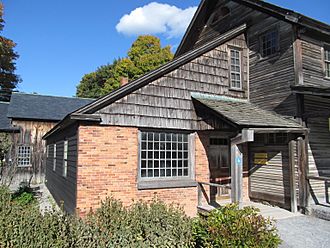The Toy Shop facts for kids
Quick facts for kids The Toy Shop |
|
|---|---|

The Toy Shop
|
|
| General information | |
| Location | Shelburne, Vermont |
| Coordinates | 44°22′39.95″N 73°13′45.38″W / 44.3777639°N 73.2292722°W |
The Toy Shop is a special building at the Shelburne Museum in Shelburne, Vermont. It's like a treasure chest filled with old toys! Inside, you can find playthings from the 1800s and early 1900s. These include tiny toy cars and trains, fun penny banks, and even old-fashioned music boxes.
Contents
History of the Toy Shop
The Shelburne Museum built the Toy Shop in the early 1950s. It was added onto another building called the Variety Unit. The Variety Unit was built way back in 1835. It's the only building on the museum grounds that was there from the very beginning!
What is Continuous Architecture?
The Variety Unit is a great example of "continuous architecture." This was a common way to build farmhouses in New England. Imagine a farmer needing more space. Instead of building a new, separate barn or shed, they would just add a new part onto their house. This created one long building that connected everything. It was super handy because farmers didn't have to go outside in bad weather to get from one part of their farm to another. The Toy Shop was built onto the back of the Variety Unit, continuing this old tradition.
Amazing Toy Collection
Playing is something everyone loves to do, no matter where or when they live! For a very long time, people have made toys when they weren't busy with important tasks like finding food. Old toys can tell us a lot about the people who made them and the children who played with them. They are like clues to the past!
Toys from Different Eras
The Shelburne Museum has a huge collection of toys. These toys come from both Europe and the United States. They were made from the early 1800s through the first few decades of the 1900s. You can see all sorts of toys, from ones made by hand to those made in factories.
Simple toys were very popular. Things like clay or glass marbles and balls made of cloth, wood, or rubber were easy to find. As technology got better, these simple toys started being made from new materials.
Learning Through Play
Did you know that educational games started appearing in the late 1700s? These games show us what skills and subjects children were expected to learn back then. As the 1800s went on, many more toys were made in factories in America and Europe. This shows how much technology was improving. It also shows that people started thinking more about childhood as a special time for fun and learning.
American Toy Making
In early American history, children played with toys from Europe or toys made at home. Small businesses in both Europe and America made wooden blocks, hobby horses, rocking horses, puppets, dolls, and other simple toys from paper, cloth, wood, and metal.
After the American Civil War (which ended in 1865), Americans became very good at making toys. They became leaders in making things like cast-iron banks. They also made miniature boats and wagons from tin, cast iron, or wood. Plus, they created cool optical toys and board games using a printing method called lithography.
Handmade vs. Store-Bought Toys
Even though the United States was making tons of toys by 1900, some people still made toys by hand. Why? Well, some toys, like whistles made from willow branches or dandelion stems, just couldn't be made in factories. Also, if families couldn't afford store-bought toys, they would often make their own.
Even rich families sometimes chose to carve a tiny cradle or a hobby horse. Or they might sew a doll dress or a puppet as a special gift. Kids also loved making their own toys! In the 1800s, there were even special books and magazines with patterns and instructions for children to make their own playthings.
See also
- Shelburne Museum
- Variety Unit
- Toy store
- Toy

